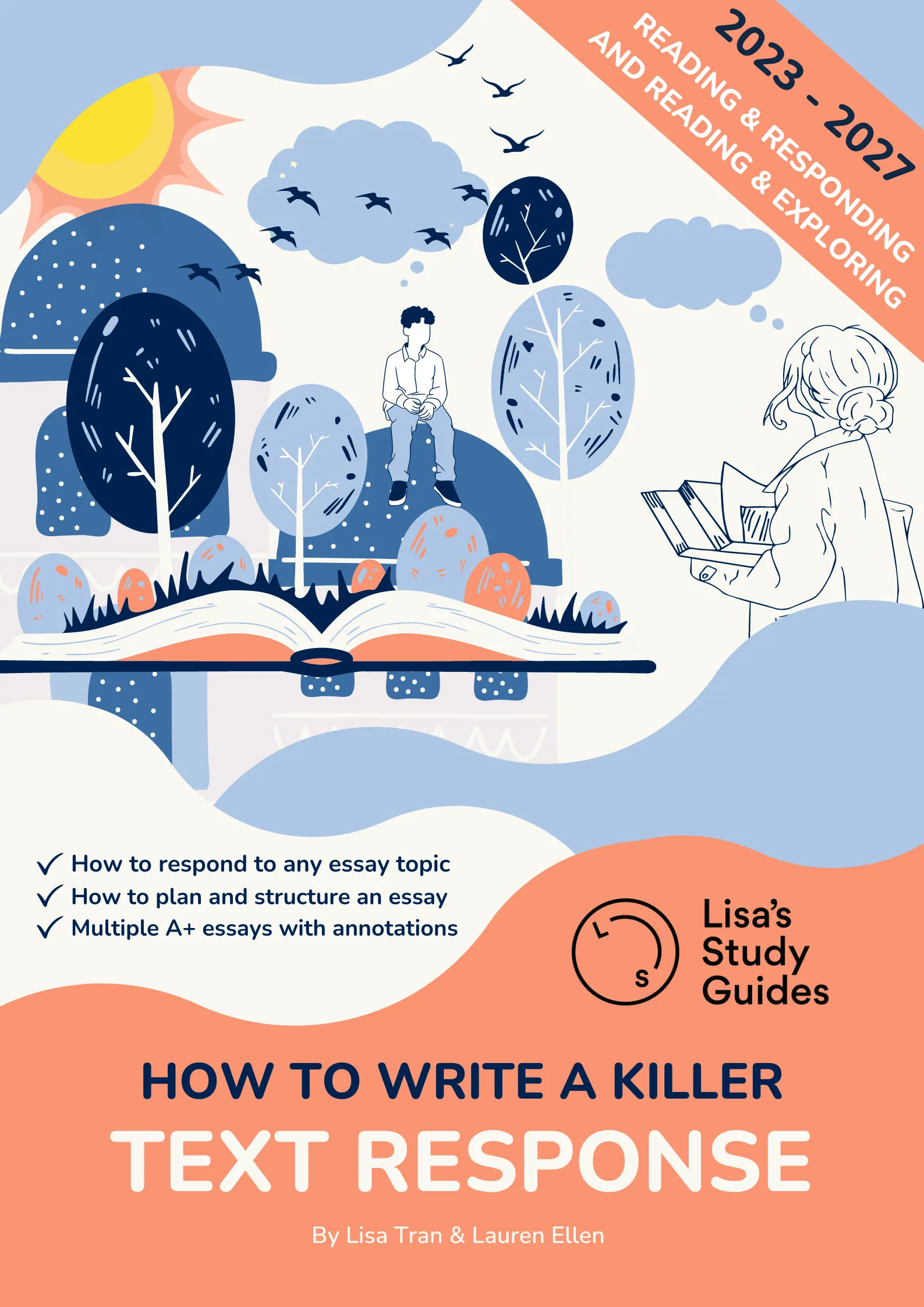Contents
1. Summary
2. Historical Context
3. Character Analysis
4. Theme Analysis
5. Sample Essay Topics
6. Essay Topic Breakdown
Year of Wonders is usually studied in the Australian curriculum Area of Study 1 - Reading and Comparing. For a detailed guide on Comparative, check out our Ultimate Guide to VCE Comparative.
However, Year of Wonders may also be studied in Area of Study 1 - Text Response. For a detailed guide on Text Response, check out our Ultimate Guide to VCE Text Response.
1. Summary
Year of Wonders is set in the small English village of Eyam in 1665, as the town struggles through a deadly outbreak of the bubonic plague. While the characters and events are fictional, author Geraldine Brooks based the novel on the true story of Eyam, whose inhabitants, at the urging of their vicar, courageously decided to quarantine themselves to restrict the spread of the contagion and protect other rural townships.
The experience of the plague provides Brooks fertile ground to develop characters that illustrate the extremes of human nature; displaying the dignity or depravity, self-sacrifice or self-interest that people are capable of when faced with terror, pain and the unknown. She explores the consequences of a catastrophe on an isolated, insular and deeply religious community and we see characters exhibit tireless dedication and heroism, or succumb to depression, exploitation and sometimes murderous depravity.
The novel illustrates that adversity can bring out the best and worst of people and that faith can be challenged and eroded. The novel explores how crises affect human behaviour, beliefs and values and reveal the real character of a community under pressure. Our job while studying this text is to consider how all the different responses to an external crisis contribute to an analysis of human nature.
2. Historical Context
Year of Wonders belongs to the genre of historical fiction (meaning it is fictional but based on historical events) and aims to capture and present the historical context accurately. The context of Year of Wonders is important to understand as it informs a lot of the division and instability in Eyam during the isolation and crisis of the plague (we explain in more detail why context is so important in Context and Authorial Intent in VCE English).
In 1658, only 7 years before the novel opens, Puritan statesmen Oliver Cromwell (who defeated King Charles I in the English Civil War and ruled as Lord Protector of the British Isles from 1653) died and Charles II, heir to the throne, returned from exile to rule England as King. Charles II replaced Cromwell’s rigid puritanism with the more relaxed Anglicanism and his reign began the dynamic period known as the Restoration. During the civil war and Cromwell’s rule, all the past certainties – the monarchy and the Church – had been repeatedly challenged and overturned. This all happened during the lifetime of the Eyam villagers presented in the novel and the recent religious upheaval in Britain was beginning to influence the conservative and puritan congregation of Eyam as the old puritan rector was replaced with Anglican vicar Michael Mompellion. The tension between the puritans and Anglicans is evident early in the novel and is exacerbated by the arrival of the plague, causing further internal fission.
The 17th century also marked the beginning of modern medicine and the Age of Enlightenment. During the Enlightenment, people began to privilege reason and sensory evidence from the material world over biblical orthodoxy as the primary sources of knowledge. The Enlightenment advanced ideals such as progress, liberty, tolerance, egalitarianism and the scientific method. These values are reflected in the liberal characters of Anna, Elinor, Mem and Anys Gowdie, and to an extent, Michael Mompellion. However, we also see the limited reaches of the Enlightenment in characters who succumb to superstition or self-flagellation when the plague arrives. This was a time when religious faith was frequently challenged and redefined.
3. Character Analysis
Anna Frith
The novel is narrated in the first person by protagonist Anna Frith. Anna, a young widow, mother and housemaid, becomes the town’s nurse and midwife during the plague alongside her employer and friend Elinor Mompellion. Anna is a compelling protagonist and narrator because she is part of the ordinary, working-class life of the village, but also has access to the gentry in her work for the Mompellions, meaning readers can see how the plague affected all social groups.
At the beginning of the novel, Anna is in many ways very conventional. Aside from her intelligence and desire to learn, evidenced by her interest and quick proficiency in learning to read, Anna married young, is a dedicated mother, had an incomplete education and never thought to question the town’s orthodox religious beliefs. However, it is revealed early that she has progressive views on class and morality and as the novel progresses, the extraordinary circumstances of the plague evoke in her heroism and courage. Brooks notes, Anna 'shrugs off the social and religious mores that would keep a weaker woman in her place'. During the plague, Anna becomes the village’s voice of reason and an indispensable figure due to her expanding medical knowledge, tenacity, resourcefulness and tireless generosity.
Michael Mompellion
Michael Mompellion is Eyam’s Anglican preacher, having been appointed three years earlier after Charles II returned to England and replaced Puritan clergies. Generally, Mompellion is altruistic and open-minded: softening strict class divisions, combatting superstition and embracing a scientific approach to the plague. When the plague arrives, the local gentry (the Bradfords) flee and due to his charisma and position in the Church, he becomes the town’s unofficial leader. Mompellion persuades the townspeople to go into self-imposed quarantine to prevent the spread of the plague. His personal charisma, powerful rhetoric and indefatigable dedication to his work mean he can motivate and inspire his parishioners.
Mompellion’s unwavering commitment to his beliefs makes him a good leader, but we also see that his single-minded religious zeal can lead to harsh irrationality and hypocrisy. While progressive on issues such as class divisions, Mompellion is conservative – bordering on fanatic – when it comes to female sexuality. When his beloved wife Elinor dies, it is revealed that Mompellion denied her sexual intimacy for their entire marriage to punish her for the premarital affair and abortion she had as a teenager. Mompellion realises upon Elinor’s death that he extended forgiveness and understanding to all but his wife and, recognising his own hypocrisy and cruelty, he suffers a breakdown and loses much of his religious faith. Through Anna’s eyes, we see Mompellion shift from a character of moral infallibility, to a flawed and inconsistent man of a more ambiguous character.
Elinor Mompellion
Elinor is Mompellion’s wife and Anna’s employer and teacher. By the end of the novel, Anna and Elinor are confidantes and friends and their friendship arguably forms one of the strongest emotional cores of the novel, sustaining both women through enormous strain and hardship. Elinor teaches Anna to read and seems not to notice or care about their different social strata, treating everyone equally. Elinor came from a very wealthy family and initially had little practical knowledge of the hardships and necessities of life. During the plague, she confronts pain, suffering and true sacrifice. Because of her beauty, fragility and generosity, the whole town – and especially Anna – view her as a paragon of virtue and the embodiment of innocence. However, Elinor reveals that as a teenager she had a premarital relationship that resulted in an illegitimate pregnancy which she ended through abortion. Elinor considers herself to be permanently marked by sin and is plagued by the guilt of her adolescent mistakes, but her commitment to atone through service and working to help others is admirable.
Anys and Mem Gowdie
Anys and her aunt Mem are the town’s healers and midwives. Both women live on the margins of society, as their knowledge of herbal medicines and power to heal certain ailments causes fear and suspicion. Additionally, Anys further alienates the villagers by having conspicuous affairs with married village men. Anna admires Anys’ herbal knowledge and healing skill and her autonomy and unashamed sexuality, which were rare for women at the time. When the plague breaks out, Anys and Mem are murdered by a mob of hysterical townspeople, who believe they are witches responsible for the plague. This episode shows the power and acute danger of superstition and hysteria.
Josiah and Aphra Bont
Josiah 'Joss' Bont is Anna’s estranged father and Aphra is Anna’s stepmother. Brooks depicts them as unsympathetic and unforgivable, if understandable, villains as they both seek to profit off the heavy misfortune of others. Joss abused Anna greatly throughout her childhood, and while she manages to forgive him due to the suffering of his own youth, when he cruelly exploits villagers in his position as gravedigger, Anna finds his actions irredeemable. As gravedigger, Joss charged exorbitant fees from desperate people to bury their dead, regularly stole from the beleaguered families and attempted to bury a wealthy plague sufferer alive to loot his home.
Aphra is similarly amoral and greedy. Although her love for her children is shown to be strong, she capitalises on the fear and superstition of her neighbours by selling fake charms while pretending to be Anys Gowdie’s ghost. After the death of her husband and children, Aphra becomes completely deranged, dismembering and refusing to bury the rotting corpses of her children and eventually murdering Elinor. Aphra’s fate and actions show how prolonged catastrophe and suffering can totally erode an individual’s sanity.
The Bradford Family
The Bradford family are arrogant and pretentious. When the plague arrived in Eyam they also proved themselves self-serving and opportunistic, exploiting their wealth and status as part of the gentry to flee Eyam instead of enduring the quarantine with the rest of the village. They provide a foil to the Mompellions, who are of similar status and are newcomers to Eyam with fewer historical ties and thus expectations of loyalty. The two upper-class families provide directly opposite responses to the crisis, with Brooks clearly condemning the cowardice and selfishness exhibited by the Bradfords.
4. Themes
Social Convention and Human Nature in a Crisis
Perhaps the most significant theme or exploration of the novel is what happens to an individual’s character and community norms in a crisis. Year of Wonders depicts a small and isolated community that experiences intense adversity from the plague and, because of their self-imposed quarantine, are additionally isolated from the stabilising forces of broader society. These factors cause the people of Eyam to increasingly abandon their social conventions and descend into chaos and Brooks raises the question of whether people can live harmoniously without a strong social code. She suggests that societal cohesion is the result of social pressure rather than innate to our nature. The social norms and protocols of Eyam collapse under the pressure of the plague, allowing discerning observers like Anna to explore the validity and value of her society’s fundamental values. Eyam’s experience of the plague demonstrates that some norms, like the limited role of women and the strict class divisions, do not need to be so repressive, while other norms and social virtues, like the rule of law and justice, are proved even more essential for their absence as order and civility disintegrate.
Brooks also explores the response of individuals to extreme and enduring adversity and questions whether crises reveal someone’s true nature or instead force them to act out of character.
Anna and Elinor are examples of characters who respond to the crisis of the plague, amongst other real hardships, with a steadfast commitment to their principles. Their innate charity and work ethic are only strengthened and bolstered by the demands of the plague. However, not all residents of Eyam respond to the plague with courage and decency. Many descend into fear and hysteria, while others become malevolent and exploitative in their efforts to protect themselves. The Bonts and the Bradfords are examples of people who act with appalling selfishness, yet Brooks is careful to illustrate them as cruel and self-serving even before the plague. Thus, Brooks appears to argue that our actions under intense duress are intensifications of our true nature.
Faith, Suffering and Science
A major theme explored in the novel is the role of faith in people’s lives and throughout the novel faith, superstition and emerging science contend with each other. Before the plague, the townspeople believe whole-heartedly in God’s divine plan – that the good and bad things that happened to them were God’s rewards or punishments for their virtues or sins. However, the plague makes this worldview unsupportable as the unremitting suffering of plague victims, depicted through gory and vividly gruesome descriptions, demonstrates that their suffering is not commensurate with their sin and that no one can deserve this fate. In particular, it is the suffering of children that most intensely shakes Anna’s faith in a divine plan. Her two young sons are early victims of the plague and their youth and innocence mean it is impossible to justify their deaths as punishment for sin. The sheer tragedy of the plague causes Anna to realise that faith in God’s plan is inadequate to explain suffering and tragedy and she looks for another explanation. This leads her to use science and medicine to ameliorate pain. By focusing on discovering possible cures or pain relievers, Anna and Elinor are indirectly treating the plague as just a 'thing in nature', eschewing the prevailing religious view that the plague is the result of God’s wrath. Their emerging scientific worldview does not rely on God’s presence and intervention in the material world and Anna loses her religious faith.
However, the scientific method and worldview were only in its very nascent form and most people held a firm belief in supernatural intervention, making the townspeople prone to superstition and, in their ignorance and fear, murderous mob hysteria.
Women and Female Sexuality
Women in Eyam had lived highly circumscribed and restricted lives until the crisis of the plague disrupted the social order. The behaviour and speech of women were heavily policed and punished. In a particularly horrifying episode, Joss puts his wife in a muzzle and parades her through the village after she publicly criticises him. While Joss is undeniably an all-round bad guy, his misogyny cannot be dismissed as singular to him. Even Mompellion, an altruistic and in some ways quite progressive man, takes a very harsh stance on female sexuality. Although he preached to adulterous male villagers such as Jakob Merrill that 'as God made us lustful so he understands and forgives', he denied Elinor forgiveness for her teenage sexual relationship and was unfathomably rageful when he discovers Jane Martin having sex outside of marriage. However, Brooks criticises the taboo on female sexuality and shows that sexual desire is an awakening and liberating force for Anna, twice helping her to come out of deep depressions and reminding her that life has joy and meaning.
There are strong feminist undertones throughout the novel as each female character exhibits strengths that the male characters do not and challenges the limitations of her role, expressing desire for more personal autonomy and agency. From the beginning of the novel, Anna admires the sexual freedom of Anys Gowdie and the ability of Elinor to unreservedly pursue her intellectual interests. During the plague, Anna finds herself eschewing her old role and social position and assuming many challenging and indispensable responsibilities that would have been unthinkable for any woman – especially a young single working-class woman – before the plague.
Leadership and Judgement in Times of Crisis
The text explores both the power of religious leaders to influence public opinion and the ability of strong and courageous individuals to rise to positions of respect and authority in a crisis. Mompellion’s natural leadership and rhetorical skill keep the community calm and bring out the spirit of self-sacrifice in them. His clear dedication to his work and parishioners inspires trust in the community, and although Mompellion comes to doubt his judgement, it is undeniable that his strong leadership and assumption of huge responsibility saved countless lives. Anna also emerges as an unofficial leader; she becomes an essential figure and the voice of reason in Eyam. The community’s newfound respect for Anna is evident in the way she is listened to and adhered to and her confidence in firmly and decisively addressing and directing men and those of a higher social class.
We see examples of powerful leadership in the novel, but we also see how an overwhelming crisis can lead to a shortage of clear leadership and expose flaws in existing governing systems. Eyam relied on its gentry (Colonel Bradford) and vicar (Michael Mompellion) to adjudicate and administer justice. However, on the advent of the plague, the Bradfords fled from Eyam and Mompellion became overwhelmed by work, leaving the townspeople to frequently administer their own justice through group tribunals or vigilante action. Additionally, the extreme circumstances of the plague mean the town must deal with crimes it has never faced before and is unsure how to punish. Brooks explores what it means to achieve justice when the only means available are faulty. There are many examples of miscarriages of justice which forces readers to think about the necessity of a strong, fair and prompt judicial system and the weaknesses inherent in these institutions.
5. Sample Essay Topics
- How does Year of Wonders explore the concept of social responsibility?
- ‘In stressful times, we often doubt what we most strongly believe.’ How is this idea explored in Year of Wonders?
- ‘Year of Wonders suggests that, in a time of crisis, it is more important than ever to hold on to traditional values.’ Discuss.
- ‘How little we know, I thought, of the people we live amongst.’ What does the text say about community and one’s understanding of reality?
- ‘Year of Wonders explores human failings in a time of crisis.’ Discuss
Now it’s your turn! Give these essay topics a go using the analysis you’ve learnt in this blog.
6. Essay Topic Breakdown
Whenever you get a new essay topic, you can use LSG’s THINK and EXECUTE strategy, a technique to help you write better VCE essays. This essay topic breakdown will focus on the THINK part of the strategy. If you’re unfamiliar with this strategy, then check it out in How To Write A Killer Text Response.
Within the THINK strategy, we have 3 steps, or ABC. These ABC components are:
Step 1: Analyse
Step 2: Brainstorm
Step 3: Create a Plan
Theme-Based Essay Prompt: ‘Year of Wonders is a story of great courage in the face of extreme adversity.’ Discuss.
Not sure what we mean by ‘Theme-Based Essay Prompt’? Then, you’ll want to learn more about the 5 types of essay prompts here.
Step 1: Analyse
The starting point of any theme-based prompt is the ideas, and while this prompt characterises the novel as one essentially about courage, it is more generally exploring the theme of how people responded to the various challenges of the plague. ‘Discuss’ questions give you scope to partially agree, disagree, or extend the prompt. It is okay to ultimately agree with the prompt but to also demonstrate the complexity and nuance of the author’s intentions, and I think that is the best approach for this essay!
Step 2: Brainstorm
As we’ve already discussed, Year of Wonders depicts a community experiencing an acute crisis and Brooks presents the very worst and very best of human nature. There are characters who display enormous courage (Anna and Elinor), others who are cowardly (the Bradfords) and those who exploit others’ hardships for their own gain (Joss Bont). There is also an entire supporting cast of characters who individually display neither extreme courage nor cowardice but who muddle through a terrible situation with numb apathy. There is also the opportunity to define what courage means here – after all, the decision to isolate themselves within the boundaries of Eyam took immense courage from all the villagers, who knew full well that they would inevitably be exposed to the deadly contagion.
Step 3: Create a Plan
Paragraph 1: [Agree] The novel is grounded in and revolves around the initial courageous decision of the villagers of Eyam to quarantine themselves and risk their own lives to protect others from the spread of the bubonic plague.
- Focus on the initial act of courage and the knowing self-sacrifice that this decision required from every single person in Eyam.
- As the event that forms the basis of this work of historical fiction, a logical argument can be made that this first act of courage in adversity forms the foundation of the novel and therefore affirms the idea that Year of Wonders is about great courage.
- However, importantly, this decision was an act of community courage that anticipated future adversity but was taken before many of the villagers had actually experienced the acute hardship and suffering of the plague. This is why it is important to now discuss the courage shown by individuals in the midst of extreme adversity [link].
Paragraph 2: [Agree] The individuals who displayed courage, hope and conviction in the face of acute personal adversity demonstrate the enormous power of courage to steel us through a crisis.
- Anna and the Mompellions concentrate on helping others and their service helped keep some degree of social order and provided comfort to victims of the plague. What they were able to achieve and provide for the community (and how much worse the situation would have been without their courageous assumption of responsibility) illustrates Brooks' high respect for courage and service.
- To demonstrate additional analytical thinking, you might consider discussing the fact that these characters were not courageous solely out of charity, but that having an occupation and something to keep them busy and focused actually became a personal survival mechanism. This further highlights the absolutely pivotal role of courage in adversity and is only reinforced through the contrast with the ignoble behaviour of those characters who did not behave courageously and forthrightly [link].
Paragraph 3: [Partial disagree] However, Year of Wonders shows how adversity can provoke extremes of human behaviour and is thus also a story of human failings under immense pressure, with many characters motivated by cowardice and self-interested opportunism.
- Here, you should discuss the dishonourable behaviour of the Bonts, the Bradfords and the hysterical mob that murdered the Gowdie women. Your aim should not only be to explain that they behaved without courage, but also to focus on the negative repercussions their behaviour had for them and the community This will help you build an analytical argument that Brooks’ core message is about the power and necessity of courage in the face of adversity.
- Ultimately, while no character escapes from the pain and loss of the plague, Brooks provides illustrations of how different people responded to their shared suffering and it is clear that she believes that the best way to respond to adversity is with the courage and strength to face the challenge head on.
---
If you found this essay breakdown helpful, let us know if you’d be interested in a complete LSG Year of Wonders Study Guide where we would cover 5 A+ fully written sample essays with EVERY essay annotated and broken down on HOW and WHY the essays achieved A+ so you can reach your English goals!






.jpeg)







.jpg)